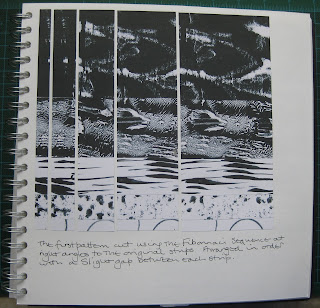'Piecing' - a method of cutting and seaming.
I just don't know where the time has gone since Summer School at Urchfont Manor, but it's good to get back to this!
This chapter is about designing with cut paper based on Seminole patchwork methods, where two pieces of fabric are seamed together and then cut and reseamed to create quite complex patterns.
2.10.1

2.10.2

2.10.3

2.10.4

2.10.5

2.10.6

2.10.7

2.10.8

2.10.9

2.10.10

2.10.11

2.10.12

2.10.13

2.10.14


2.10.15

The last task is make a mosaic by continually cutting and seaming, starting with a strip of black material and a strip of white material joined together. A section (the first in the Fibonacci sequence 1 - 2 - 3) is cut off and retained. The remaining section is cut and reseamed twice and then another section (the second in the Fibonacci sequence 1 - 2 - 3) is cut off and retained. The remaining section is then cut and reseamed as often as possible.

The last task is make a mosaic by continually cutting and seaming, starting with a strip of black material and a strip of white material joined together. A section (the first in the Fibonacci sequence 1 - 2 - 3) is cut off and retained. The remaining section is cut and reseamed twice and then another section (the second in the Fibonacci sequence 1 - 2 - 3) is cut off and retained. The remaining section is then cut and reseamed as often as possible.
I found it quite difficult knowing when to stop, so I decided to take photos at various stages. For this first image, I laid the tree sections together.
2.10.16

I took this second image after I had cut and reseamed two more times, and once again the three sections are laid together.

I took this second image after I had cut and reseamed two more times, and once again the three sections are laid together.
I cut and reseamed twice more, but this time, I joined the fabric by butting up the edges of the fabric and using a zigzag stitch. I also cut and reseamed the second section once, to further delineate it from the top section and give a smoother transition between the sections.
I particularly like the uneven edges of the third section, and didn't want to loose that by making a seam, so to join the second and third sections together, I laid one over the other and topstitched.
I probably could have done some more cutting and reseaming, but I like the fractured nature of what I've got, with the differences in the size of the shapes, and felt I should stop there.
I enjoyed doing this - It would be fun to do it in colour.


































